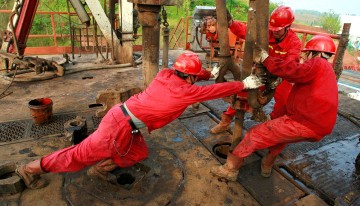

China's bold move into the oil sands
"The deal does not commit the company to delivering oil to the Chinese.... 'At the end of the day, there was nothing tied in terms of transporting or pipelining. This was just strictly an energy venture that PetroChina identified that had very high quality, and had a great management team that can move this forward in a timely manner.'”
Nathan VanderKlippe
Globe and Mail
Tuesday, Sep. 01, 2009
 Workers at a PetroChina oil field in Tongnan, southwest China's Sichuan province. REUTERS |
PetroChina's $1.9-billion acquisition of stake in Athabasca Oil shows deep-pocketed investors still see value in Alberta resource
A major Chinese energy company has delivered a jolt of confidence to Canada's oil patch with a $1.9-billion investment that marks China's biggest entry into Alberta's oil sands.
In a deal that many took as proof of the oil sands' continued attractiveness to deep-pocketed investors, Calgary-based Athabasca Oil Sands Corp. on Monday sold a 60-per-cent interest in two of its undeveloped projects near Fort McMurray to the international unit of PetroChina Co. Ltd. (PTR-N110.440.690.63%) .
The transaction will hand approximately three billion barrels of Alberta oil to PetroChina, whose parent is the state-owned China National Petroleum Corp., but will leave operation of those projects, named MacKay River and Dover, in Canadian hands.
Chinese companies have engaged in a months-long buying spree of global petroleum assets, snapping up a refinery and oil and gas properties in Asia, Russia, South America and Africa. But for those in the oil patch, the acquisition of Alberta assets serves as a much-needed vote of confidence.
Canada's energy industry has spent more than a year watching oil prices fall and, in their wake, tens of billions in capital spending cancelled or delayed. Many see the Athabasca deal as a sign that stability – and even growth – is returning.
On a day when falling crude prices sank shares in most energy companies, several small oil sands players, most notably UTS Energy Corp. and OPTI Canada Inc., saw big gains on hopes that they, too, could become acquisition targets.
“It signals the return of a higher level of capital spending in the oil sands,” said Mike Tims, the chairman of Calgary investment firm Peters and Co.
“When Kearl was approved, it lifted the psychology significantly, because people could see the return of capital spending again. And I suspect this will have the same kind of effect.”
In May, Imperial Oil Ltd. decided to begin construction of its $8-billion Kearl oil sands mine, the first major oil sands project to be revived after last year's crash.
The Athabasca deal will provide the Calgary-headquartered company, which is 25-per-cent owned by management and directors, with enough capital to finance its share of a planned series of oil sands extraction plants that could one day produce between 400,000 and 500,0000 barrels of crude per day. The company estimates the capital required for those plans at $15-billion to $20-billion, but says it will benefit from technological advances being developed by PetroChina at some of its heavy oil assets in China, which have similar characteristics to the oil sands.
“From our perspective, we're very excited about having the opportunity to partner with such a large and substantial company that has the technological capabilities to help move this forward,” Athabasca chairman Bill Gallacher said.
The deal does not commit the company to delivering oil to the Chinese, he added. “At the end of the day, there was nothing tied in terms of transporting or pipelining. This was just strictly an energy venture that PetroChina identified that had very high quality, and had a great management team that can move this forward in a timely manner.”
The deal also includes a “financing arrangement” that Athabasca will use to refinance a $400-million bond it secured last year, although the company declined to provide any details. Athabasca will continue to operate the rest of its assets independently. It expects the PetroChina deal to close Oct. 31, and said it expects government approvals to pose little obstacle.
Chinese companies have attracted attention for their bids this year to buy two Canadian-listed companies with foreign assets – Verenex Energy Inc. and Addax Petroleum Corp. – but they have made steady inroads into the oil sands as well. Earlier this year, Sinopec raised its stake in French giant Total SA's Northern Lights project to 50 per cent. In 2005, the Chinese National Offshore Oil Corp. spent $150-million for a 16.7-per-cent stake in privately-held MEG Energy Corp, while in 2007, CNPC bought 11 oil sands leases containing reserves of about 1.9 billion barrels.
For many, however, the Athabasca deal was notable for the value it assigned to oil sands assets, whose worth has been debated ever since Total made a hostile bid for UTS earlier this year that analysts said ascribed no value to its oil reserves. Analysts calculated that PetroChina will pay just over 60 cents a barrel for Athabasca, which marks a return to some of the valuations seen in 2007 and 2008, and implies a value for companies like UTS that is roughly double their current trading price.
“I think you'll probably hear UTS speak up a lot more and saying, ‘Look, here's the valuation,'” said FirstEnergy Capital analyst William Lacey.
Athabasca's MacKay River and Dover projects contain an estimated five billion barrels of recoverable bitumen. Athabasca plans to extract those barrels with technology known as steam-assisted gravity drainage (SAGD). Unlike oil sands mines, SAGD operators use underground injections of high-pressure steam to coax the thick bitumen to the surface.
Athabasca has applied for permission to build two pilot projects, but does not expect to begin commercial production until at least 2014, when it hopes to turn on an initial, 35,000 barrel-a-day phase of production from MacKay River.
Posted by Arthur Caldicott on 01 Sep 2009